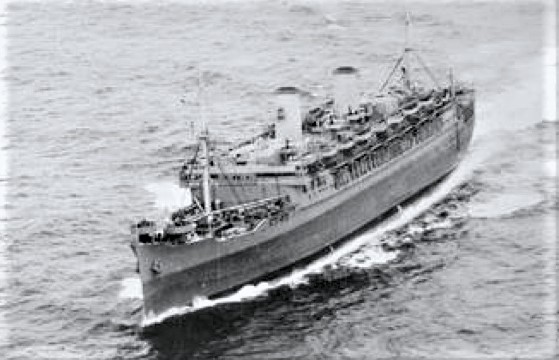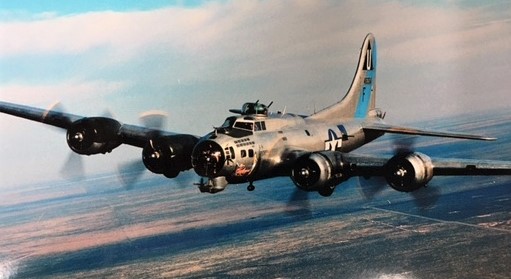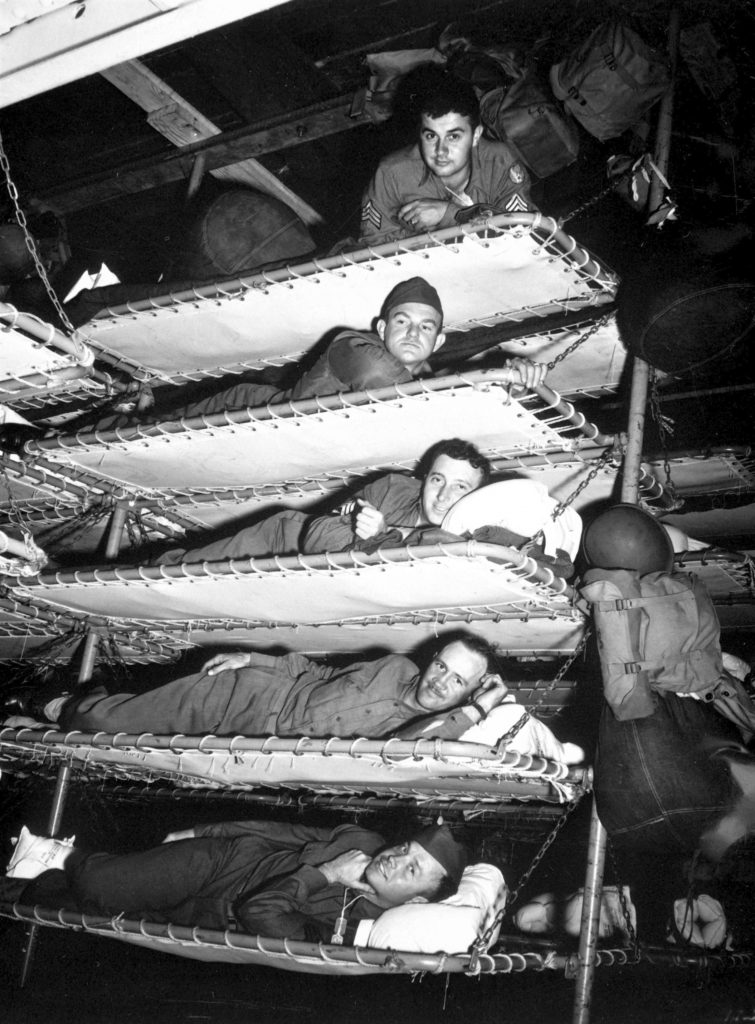Going to War

You’ve finished training, you’re inoculated, and your paperwork is filed. Now, it’s time to board an overloaded, repurposed luxury liner and outlast the chaotic sea and a determined enemy. You know not your destination, that they will tell you along the way. Your only clue is that you are sailing west from California.
Fifteen million men and women of the United States armed forces faced similar circumstances during World War II. Not all were going to India like the 721st Railway Operating Battalion and the five thousand GI’s in their Military Railway Service (MRS), but all were bound for the unknown. On Veterans Day, 2019, I hope this vignette helps us appreciate those who served at a moment in their lives when all that came before resolved into what lies ahead.
This vignette precedes the narrative in Rails of War, the story of my father’s railway operating battalion in World War II. The book follows the men of the 721st on their journey to India, through their twenty-two months in-country, through fires and famine, monsoons, and crippling heat, as they move the weight of war on a foreign, outdated system. At war’s end, with their mission accomplished, their return trip takes them around-the-world. If you’d like to read more about the 721st and the China-Burma-India theater, the book is widely available.
9 December 1943, 1600 Hours – Camp Anza, California
A gaggle of GIs went to the orderly room to check the shipping list the evening before, and there they were. Amidst the anxious cluster of young men staring at the cork bulletin board, one anonymous soldier piped, “Well boys, I guess it’s time for a boat ride. Don’t forget your swimsuits and bathing caps.”
The 721st had finally received orders to ship out, but the rumor mill had been working overtime for two days before that. Word had reached them from the docks in Wilmington that their locomotives, rolling stock, section equipment, and machine tools had arrived. So, they knew it wouldn’t be long.
Besides getting their gear organized and stocking up on last-minute purchases, most men wrote home knowing that they would not be able to mail any more letters until they got to wherever the Army was sending them. By then, all mail home would be subject to enemy attack. They had been under a communications blackout since furloughs were canceled at Camp Atterbury after Thanksgiving – no letters, no telephone calls, and no telegrams.
They didn’t much regret leaving Camp Anza. The camp had beer, malted milk, and ice cream at the Post Exchange. It had a comfortable movie theater and an enormous mess hall with generous portions of good chow, and all the fresh fruit the men could eat. Still, it wasn’t a place where you spent much time or grew attached.
The camp was named for the intrepid Spanish explorer, Juan Bautista Anza. In the 1770s, Anza was the first European to establish an overland trail from Mexico to the Pacific coast of California through the continent’s hottest desert, the Sonoran. The Spanish had been looking for such a route for over two hundred years. Like Señor Anza, most GIs were simply passing through.
In 1942, the federal government bought 1,239 acres sixty miles east of Los Angeles from the heirs of Willits J. Hole, a wealthy businessman, landowner, entrepreneur, and successful yacht racer of the 1920s. Construction began in July 1942, and the base was finished in February 1943. The Camp was officially activated in December 1942 as Headquarters, Arlington Staging Area.
Stays at Camp Anza were brief. The 721st spent ten days there. But the total population of the base often ranged up to twenty thousand. It was a bustling beehive of activity through which more than 600,000 troops passed during the war.
Camp Anza was a staging area whose purpose was to prepare soldiers for overseas deployment. Base personnel immunized soldiers and helped them write their wills. APO mail numbers were assigned so that loved ones could stay in touch. Furlough pay was issued. But Anza wasn’t all paperwork and needle pokes. The men practiced going over the side and became awkwardly proficient descending ship cargo nets.
The men checked and re-checked their clothing issues, and ordnance teams checked and re-checked their arms. Experts from the Chemical Warfare Section marched them into their final gas chamber to check their gear, and camp staff remedied all shortages and deficiencies.
Instructors held orientation sessions on foreign customs, and languages and outbound soldiers were briefed on the rules of war. The bureaucracy put to work hundreds of clerks to make sure the Army’s paperwork was in order, and at 1600 hours, 9 December 1943, the 721st Railway Operating Battalion was generating one of the final clerical entries in its stateside file.
The men stood at attention outside the orderly room for roll call. Sergeants noted anyone absent by circling their names on the alphabetized lists. If you were present, you got a checkmark.
After completion of the Army’s final inventory came the heavy lifting. Men heaved their eighty-pound duffle bags, shouldered their twenty-pound horseshoe rolls, braced their forty-pound packs, lugged their brand new gas masks, goggles, and protective capes, straightened their wondering twelve-pound musette bags and handed off their ten-pound carbines and eleven-pound Thompson sub-machine guns to buddies as they climbed aboard the shuttle train to Wilmington.
Stumbling his way up the steep steps onto the U.S. Maritime Commission passenger car, a nameless voice in the line said to no one in particular, “Well, at least we won’t have to worry about Jap subs, boys. With all this gear, we’ll sink at the dock.”
After all the grumbling and stumbling, the men settled in, and the train whistle blew as the Camp Anza Band struck Fred Waring’s popular tune This is My Country. As the locomotive took up the slack and the train pulled slowly away, steam hissed from the boiler valves, and coal smoke descended on the tuba and French horn sections, making them disappear in a cotton-like haze. But the band played on.
Through the orange groves and vineyards, the sun faded, and the electric lights in homes revealed families at dinner. Their calmness and normalcy struck the men as oddly out-of-place, like misplaced frames in a disjointed movie reel.
It was 1900 hours, and the sun dipped on the western horizon as the troop train reached the station at Wilmington. Some soldiers had fallen asleep with their four-pound steel helmets, and plastic liners pulled over their eyes, and others were wide-awake taking in the view from the passenger car windows.
The big locomotive coaxed the train to walking speed then pulled to a smooth passenger stop under the train shed. Many of the operating craft personnel silently noted the engineer’s skill.
The soldiers detrained and formed-up in a huge galvanized steel warehouse, one of many lining the dock. Officers called out the men’s last names, and when they answered with their first and middle initial, the sound echoed like they were yelling in a giant metal cave. Dozens of call and response exchanges took place all at once as 5,000 men assembled to board the ship in a cacophony of roll.
They lined up by twos and were greeted by ladies from the Red Cross with sandwiches, coffee, and cookies. After the quick but welcome snack, and a faint foreboding that they had eaten their last meal in the U.S., they began to march from the warehouse and past rows of docked ships towards the gangway of the S.S. Mariposa.
By now, everyone was wide-awake. Heads swiveled as awe-struck young men from the Midwest and other non-coastal states cataloged their strange new surroundings – the squawking, insistent gulls, buoys gonging in the harbor and the smell of saltwater. It was the first time most of the 721st had seen ocean-going vessels and the massive equipment needed for their maintenance. These were men who, for the most part, were familiar with large industrial settings and oversized equipment, but “My God,” many thought, “These things are enormous!”
The entire coastline from Los Angeles down to Long Beach Harbor, including the embarkation point at Wilmington, was a nexus of military operations and commercial activity. It presented the Japanese with a tantalizing target.
The maritime geography of Long Beach was opportune, and its doubly protected west basin port was only minutes from the open sea. The most concentrated stretch of tempting targets ran from Long Beach up to San Pedro and proffered an enticing strip of naval bases, shipbuilding properties, repair slips, docks, wharves, Coast Guard berths, supply depots, and oil fields.
Immediately before World War II, the U.S. Congress authorized the construction of a major anchorage and set up a fleet operations base called Terminal Island Naval Dry Docks in Long Beach. The docks began working on ships in April 1942, and by August 1945, employed over 16,000 civilians. These skilled workers provided battle damage repairs and routine maintenance to tankers, cargo ships, troop transports, destroyers, and cruisers. Consolidation Steel Corporation ran an eight-way shipyard next door in Wilmington building landing craft for the Marines and other ships. They employed over 12,000. The entire area was a twenty-four hours a day, seven days a week operation, and a busy place, even without the wide-eyed men of the 721st.
As they marched in loose formation under the bows of the iron giants, one wisenheimer in the rear ranks piped, “Hey, upfront! Turn right when you see the red carpet!”
A moment later, the same guy yelled up at a seaman, mopping the forecastle of a Coast Guard cutter, “Hey, Cap’n Ahab! Swab that deck and hoist that bale! I’m coming aboard the Pequod for inspection!”
He was still giggling and mouthing an unlighted cigar, delighted at his literary reference when the soapy water from the sailor’s bucket hit squarely on his helmet. It was a well-placed shot, and the GIs around him laughed hysterically though some got splashed as well.
The chuckling men were still ribbing the wet wisenheimer when their banter was drowned out from behind by two B-17G Flying Fortresses approaching low over the docks. The deep pulsating signature of their eight 1,200-horsepower Wright Cyclone GR-1820-65 radial engines shook the pier beneath their Type I service shoes disorienting the men.

As they overflew the 721st column at less than 500 feet, the men gawked at the machine guns poking out of every conceivable surface of the plane, thirteen in all. The German Luftwaffe fighter pilots sent to intercept these monsters called the plane vier motor schreck or four-engine fear.
When the lead plane was within view of the whole column, the pilot slowly dipped the big wingtips, first the right and then the left. Then, with the low western sun glinting off their aluminum fuselages, the enormous birds banked right as if controlled by one mind and climbed into the warm Pacific sky soon out of sight. The men on the dock had no way to know, but the lead bomber was crewed and piloted by Class 5 qualified women of the U.S. Army’s Sixth Ferring Group, WASPs. They flew everything from trainers to Fortresses.
The sound of their powerful engines faded as the planes lumbered away from the waterfront. The B-17Gs were brand new on their way from the Douglas Aircraft plant in Long Beach to somewhere in the Pacific. The Long Beach Douglas plant was one of three making B-17Gs and on average, assembled four of the giant planes a day. The three plants combined turned out thirteen new bombers a day, and all were promptly put to use making rubble and carnage out of buildings and machinery and troops formerly prized by enemies.
As the aircraft passed from sight and earshot, a staff sergeant marching to the left of Company B thought to himself, “That might have been me if the railroad hadn’t jinxed things.”

The head of the column reached the gangway of the S.S. Mariposa and began climbing the long steps single file as each man’s name was read. The men below watched as their comrades disappeared into the yawning hole midship in the boat’s gray steel side.
Once inside the ship, the men were assigned quarters and told to go there and remain there until further notice. They dutifully wandered off through a maze of hatches, bulkheads, and companionways tunneling through a jungle of pipes and wiring.
Some of the lucky ones drew staterooms, but most found their ways to three-tiered bunks made of iron frames and canvas with rope slings. A few slept in hammocks built into every irregular nook and cranny of the boat. Some even had to sleep on deck in four-layer bunks protected from the wind and elements by plywood. These poor souls couldn’t even read after dark because they could use only blue lights to maintain blackout.

But all told, the men on this voyage were lucky. The Mariposa had made trips across the Atlantic, ten-day runs, where she carried twice as many men. On trans-Atlantic crossings, the soldiers shared bunks and slept in twelve-hour rotations. But the Pacific crossing was different. The men of the 721st would be at sea for a month with a brief stop in Hobart, Tasmania, for fuel and water.
A line of men not yet to the gangway eyeballed the Mariposa as they approached. They watched the twin loading masts, one astern and one on the bow, lift aboard pallets and cargo netted items. They studied the crew securing items to the deck and delivering loads into holds. It looked like a well-oiled operation, and that was heartening.
The big gray boat was longer than two football fields and had dozens of inflated life rafts tried along the railing on what looked to be the promenade deck. The inflated rafts were in addition to the wooden lifeboats mounted above the rafts on the same level as the twin smokestacks. The inflated rafts were obviously an improvised measure, and they were both reassuring and disquieting at the same time.
At 18,017 gross tons, the S.S. Mariposa was a large ship for her day. Designed by Gibbs and Cox, Inc. and built by the Bethlehem Shipbuilding Corporation in Quincy, Massachusetts, she was launched for the Matson Navigation Company in Los Angeles in July 1931. She was laid out to accommodate 475 first-class and 229 cabin class passengers along with 359 crewmembers. On this trip, she’d be a floating home and potential Japanese target for nearly five thousand souls, including the 651 enlisted men, 21 officers, and 1 warrant officer of the 721st Railway Operating Battalion.
The S.S. Mariposa entered troop carrier service in 1941. Her two Bethlehem Steam Turbines produced 28,450 horsepower and turned twin screws that could make 22.8 knots. The Mariposa wasn’t particularly fast, but she wasn’t slow, either.
She might outrun a sub that stayed submerged, but since she wasn’t heavily armed, a sub could always surface, chase her down and shell her or submerge and launch torpedoes. Any Japanese surface vessel worth its salt would have no problem outpacing her.
The Matson Navigation Company relinquished four passenger liners for troop transport after the attack on Pearl. The Mariposa and her three sister ships, the Lurline, Matsonia, and Monterey, would complete a wartime total of 119 voyages, covering one and a half million miles to deliver over 736,000 troops. A sterling and reassuring wartime contribution. Still, in 1943, no one knew the outcome of the war, let alone the fate of a single ship on a hostile ocean.
So, if anyone aboard the S.S. Mariposa the misty morning of December 10, 1943, had somehow yet failed to grasp the grand premise to which they were now party, it all became clear as the gangway rolled back, the anchor was weighed, the mooring lines were cast, and the foghorn sounded. As tugs began maneuvering the big ship to the channel, past the submarine nets, barking seals and minefields, every man on board the crowded ship somehow felt alone.
Their passage would deliver them to a strange realm halfway around the world. The journey would be made without escort or defense, and the lumbering ship would ply waters where the enemy was active, engaged, and deadly accurate.
Overfilled with men and matériel, they would be hard-pressed to outmaneuver or outrun anyone intent on sinking them. They weren’t so much a sitting duck as a big, fat, lame Mallard with only one leg to paddle. But they were smart. They had a few tricks of their own, and they had no intention of being plucked, stuffed, and mounted on the mantel of some lucky captain of the Imperial Japanese Navy.
So, Uncle Sam wished them all bon voyage, God Speed, and recommended that they kiss any rabbit’s foot, shamrock, Saint Christopher’s medal, or Shekel that they might have handy because the odds were with the other guys on this trip. – SJH





